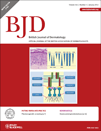Correlation between lipoprotein(a) and lipid peroxidation in psoriasis: role of the enzyme paraoxonase-1
Funding sources None.
Conflicts of interest None declared.
Summary
Background Psoriasis is a chronic, inflammatory skin disease associated with abnormal plasma lipid metabolism and with a high frequency of cardiovascular events. Modifications of plasma lipids and an increase in the levels of biochemical markers of lipid peroxidation have been reported in subjects with psoriasis, suggesting a relationship between psoriasis, lipoproteins and oxidative damage.
Objectives To investigate further the relationship between lipoproteins and oxidative stress in psoriasis.
Method The levels of plasma lipids, lipoprotein(a) [Lp(a)] and markers of lipid peroxidation were evaluated in subjects with psoriasis (n = 23) and in controls (n = 25). In the same subjects, the activity of paraoxonase-1 (PON1), an antioxidant and an anti-inflammatory enzyme associated with high-density lipoproteins, was investigated.
Results The results showed higher levels of Lp(a) in the serum of patients with psoriasis compared with controls (P < 0·001). Higher levels of lipid hydroperoxides (P < 0·001) and lower PON1 activity were observed in the serum of patients compared with healthy subjects, confirming that psoriasis is associated with oxidative stress. The imbalance between oxidative stress and antioxidant enzymes, and the increase of Lp(a) serum levels was related to the extent and severity of psoriasis. Finally, our results demonstrated that Lp(a) levels were positively correlated with markers of lipid peroxidation and negatively related to PON1 activity, suggesting that subjects with higher levels of Lp(a) are more exposed to oxidative damage.
Conclusions Our results provide further evidence that oxidative stress and impairment of the antioxidant system in the plasma of patients may play a role in pathogenesis and progression of psoriasis and related complications.




